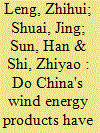|
|
|
Sort Order |
|
|
|
Items / Page
|
|
|
|
|
|
|
| Srl | Item |
| 1 |
ID:
171370


|
|
|
|
|
| Summary/Abstract |
China has become the leader in the wind energy industry and the “Belt and Road Initiative” provides a broad stage for China's international cooperation in this field. This paper examines the trade status of China's wind energy products in the “Belt and Road” countries, and measures the export potential and its determinants in the market of these countries, by adopting the gravity model with a balanced dataset of 19 products and 65 countries covering the period 2007–2017. The results indicate that: (1) China's wind energy product trade with the “Belt and Road” countries has grown rapidly, but the market structure is relatively concentrated; (2) The GDP and total energy consumption of the importing countries and China's wind power generation capacity have a positive impact on China's exports of wind energy products, while the physical distances between capitals of China and the importing countries have a negative effect; (3) The traditional market for China's wind energy product exports is becoming increasingly saturated, and 35 countries with untapped potentials and the growing markets are mainly distributed in the CIS, East Asia, West Asia, Central Asia and South Asia. Finally, this paper proposes corresponding policy implications based on these findings.
|
|
|
|
|
|
|
|
|
|
|
|
|
|
|
|
| 2 |
ID:
137693


|
|
|
|
|
| Summary/Abstract |
This study aims to estimate carbon intensity abatement potential in China at the regional level by proposing a particle swarm optimization–genetic algorithm (PSO–GA) multivariate environmental learning curve estimation method. The model uses two independent variables, namely, per capita gross domestic product (GDP) and the proportion of the tertiary industry in GDP, to construct carbon intensity learning curves (CILCs), i.e., CO2 emissions per unit of GDP, of 30 provinces in China. Instead of the traditional ordinary least squares (OLS) method, a PSO–GA intelligent optimization algorithm is used to optimize the coefficients of a learning curve. The carbon intensity abatement potentials of the 30 Chinese provinces are estimated via PSO–GA under the business-as-usual scenario. The estimation reveals the following results. (1) For most provinces, the abatement potentials from improving a unit of the proportion of the tertiary industry in GDP are higher than the potentials from raising a unit of per capita GDP. (2) The average potential of the 30 provinces in 2020 will be 37.6% based on the emission's level of 2005. The potentials of Jiangsu, Tianjin, Shandong, Beijing, and Heilongjiang are over 60%. Ningxia is the only province without intensity abatement potential. (3) The total carbon intensity in China weighted by the GDP shares of the 30 provinces will decline by 39.4% in 2020 compared with that in 2005. This intensity cannot achieve the 40%–45% carbon intensity reduction target set by the Chinese government. Additional mitigation policies should be developed to uncover the potentials of Ningxia and Inner Mongolia. In addition, the simulation accuracy of the CILCs optimized by PSO–GA is higher than that of the CILCs optimized by the traditional OLS method.
|
|
|
|
|
|
|
|
|
|
|
|
|
|
|
|
|
|
|
|
|